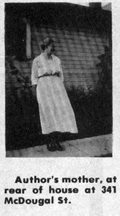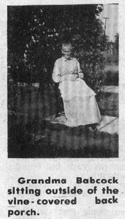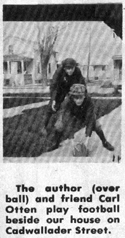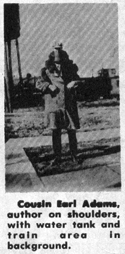November 10, 1983




Picture #1 (missing) – Author, with younger sister, Virginia, and our cat, Dick.
Picture #2 (missing) – Author’s older sister, Ruth, with Polly, our parrot.
Picture #3 – Author’s mother, at rear of house at 341 McDougal St.
Picture #4 – Grandma Babcock sitting outside of the vine-covered back porch.
Picture #5 – The author (over ball) and friend Carl Otten play football beside our house on Cadwallader Street.
Picture #6 – Cousin Earl Adams, author on shoulders, with water tank and train area in background.
There’s still more to tell about those days long ago, when the author lived at 341 McDougal St.
Today’s article, mostly stories from the past, includes a number of photos taken when my family lived in that location, helping to illustrate some of the text and acquaint readers with the family.
One of those pictures shows Dick, our cat, a big, gray Tom. One time, Dick must have gone mouse-hunting. We missed him for a day or so, then we heard him meowing close to our house in some high weeds. He had gotten caught in a large, heavy trap, the type used by trappers. One foot was in the vice-like grip and he was in terrific pain. (I guess), because it was a job to extricate him. Our only cousin, Earl “Goat” Adams, discovered who had set the trap (for rats) and gave the man a good lecture.
RAILROADS IMPORTANT THEN
Train-watching was one of the pastimes back then because of the busy railroads hauling coal, freight and passengers. Living just a stone’s throw from three of them, The Hocking Valley, Toledo & Ohio Central, and The New York Central, there were always trains to watch.
The engines were all steam-operated, which meant that the water reservoir on each engine had to be kept full to make steam. Therein is another tale.
Just opposite our house was a large wooden tank built on a super-structure about 25 feet in the air from which water was pumped to the location on the main track to be transferred to the engine. A partial view of the elevated storage tank can be seen in one of the accompanying photos. One Sunday morn- ing when we rose, we discovered that the tank had burst and lay as a mess of wooden debris on the ground. They never rebuilt the large supply tank. The trains had to get their water at another station along the line.
During World War I, long troop-trains went through Fostoria, some of them on the Hocking Valley and New York Central. The soldiers were always waving and cheering from open windows. Also, in the summer, long passenger trains went through here loaded with people on the way to the Shrine at Carey for healing services.
Events like those just described always evoked waving by both train travelers and townspeople watching. It was a natural thing to do. The trainmen in the engines and caboose always waved to watchers as they passed by. I don’t know if that is still a practice.
WHEN CIRCUS CAME TO TOWN
Not many kids know about the circus days of the past. Fostoria was a great circus town because of all the railroads. Circuses could get to this town from all directions since they traveled by trains.
Circus days was a big event when I was a boy living on McDougal Street. We always got up at daybreak and went to the railroad siding where the circus unloaded, and later went to the field where they set up for the day.
What fun it was to watch the horses and elephants come out of the cars that carried them. As those big mighty elephants came out they lined up for the walk to the circus field, each elephant’s trunk grasped the tail of the one in front, and that’s the way they marched to the field. At the field they helped erect the big circus tent and moved other equipment into place with their super strength.
KIDS WORKED FOR FREE PASS
Many of the kids who went to the circus field early that day got a job and earned a ticket to the afternoon performance. Some kids carried water for the elephants; others helped set up spectator seats; others did any other odd jobs which were available. On one circus day your author worked in the dining tent, carrying food from the cook tent to the tables where the circus workers ate, many of whom were black men. I recall the menu for that day…boiled potatoes, fish, bread, coffee, all in large quantities.
Once when Ringling Brothers Circus came to town, they unloaded at the railroad siding at East Tiffin Street. I was one of those present to watch the circus actors and actresses leave their coaches. Joy Huss, living on East Tiffin Street, was with me. When the sideshow fat lady came down the steps, Joy shouted, “What do you eat to make you fat?” With a big smile on her face the fat lady replied, “Strawberry shortcake.” The crowd roared with laughter. So there, now you folks on a diet know what not to eat.
POLLY OUR PET PARROT
One of the accompanying photos shows my older sister, Ruth, with “Polly,” our parrot, when we lived at 341 McDougal St. Some readers who lived in the east end of town my remember Polly…some have mentioned it in the past.
In the summer, the parrot was often on one of our porches facing Cadwallader Street. It would sometimes say to passersby, “Hello, Polly,” or, “Pretty Polly,” or, “Pretty boy.” Our back porch in summer was almost totally enclosed with morning glories or wild cucumber vines.
I remember when they put slate on all five of the houses which Mr. Funk now owns. The slate replaced wood shingles which were originally on all the roofs. Huge amounts of the slate were hauled in front of the houses. One man did nothing but punch nail holes in the slate on a manually operated machine. That slate must have been installed in about 1914 or 1915.
GENO WILSON PAVED McDOUGAL
McDougal had an unpaved dirt street. In summer when we had a hard rain, the water didn’t drain away fast since there were no sewers. At times the water got deep enough for us kids to wade around in.
Then came the day when it was paved with bricks. “Geno” Wilson declared the champion bricklayer, laid them. The street was vastly improved, but our wading hole was gone.
One summer, the kids who lived in the 300 and 400 blocks of McDougal Street had a baseball team named The McDougal Street Sissies. We played mostly on the National Carbon Co. Field where the City Industrial Baseball League played part of their games. I can’t recall all of the names of the kids who were on the team besides me, but those I do recall are Art Rothaker, a couple Burkhart boys, a Stone boy, and perhaps Paul Morris and Carl Otten. I don’t know if that was the same summer or another, but I played so much baseball that my throwing arm was disabled. Mother took me to Dr. Hale. He wanted to know what I had been doing. When I told him, he put my arm in a sling and recom- mended that I give it a rest.
BUBBLE-BLOWING WAS PASTIME
Your author liked to blow bubbles as most kids do. When I took the tour of the house where we lived, and came to the top of the stairs to the second floor, I looked out of the window there and was reminded it was there that I especially like to blow bubbles. At the second-floor level, the wind would catch the bubbles and carry them several hundred feet before bursting.
That top-of-the-stairs location reminds me of another story. A man living across the railroad tracks on McDougal spent much of his spare time in saloons and sometimes went home very intoxicated. Everyone was fearful that he would be killed by a train, but I guess the good Lord had pity on his condition and put an angel in charge.
One night, late, he had drunk too much and stopped at our next-door neighbor’s whom he knew. Going up on the porch he stumbled, fell, and broke a large flower pot. It was through the window where I blew bubbles that we saw him trying to pick up the pieces and heard him talking to the broken pot and the flowers, apologizing to them for his actions. Then, it sounded amusing, but later, and now, it typifies the terrible influence of alcohol.